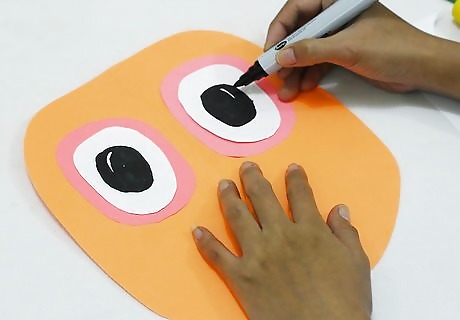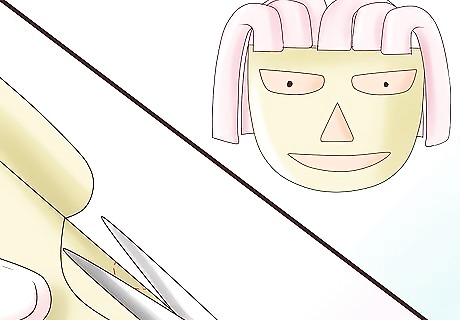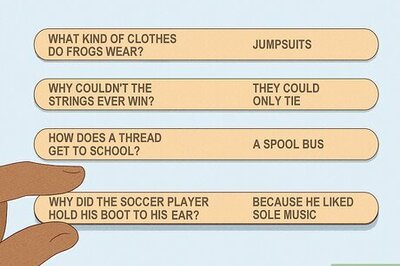
views
Making a One-Color Drama Mask

Cut a shield-shaped outline from a piece of construction paper. These instructions show you how to make a mask resembling the "comedy" and "tragedy" masks that are often used to symbolize the concept of drama. Though the expression on each of these masks is different, the overall shape of both masks is the same - roughly the shape of a rounded shield or crest. Cut this shape from your piece of construction paper. You'll want to use most of your paper so that your mask is big enough to cover your face.

Use enlarged comma shapes for the eyes. Both the comedy and tragedy masks use the same basic shape for the eyes - a rounded comma or half-crescent shape with one thick end and one tapering end. However, based on whether you're making the comedy or tragedy mask, the placement of these shapes changes. For the comedy mask, cut the comma shapes into the mask so that the thick ends face outward. This imitates the merry, rising cheeks of a laughing face.For the tragedy mask, cut the comma shapes so that the thick ends face inward to imitate the furrowed brow of a sad or dismayed face. In either case, cut out the eyes by gently folding the mask so that you're able to cut spaces in the center of the mask without cutting in from the side.

Use a jellybean shape for the mouth. As with the eyes, the basic shape of the mouth in both the comedy and tragedy masks is the same, but the orientation of the shape changes. For the comedy mask, draw a smile by cutting an upward-curving jellybean shape. For the tragedy mask, flip this jellybean shape upside down to create a frown. Again, in either case, fold the paper and make a small cut in the middle of your shape to allow yourself to cut out the mouth without having to cut in from the side of the mask.

Glue a popsicle stick to the mask. Often, tragedy and comedy masks are represented as being attached to sticks that a performer can use to hold them in front of his or her face. You can recreate this with a popsicle stick - simply glue a popsicle stick to the bottom or the side of your mask to give yourself a handle with which to hold your mask. If you don't have any popsicles in your freezer, you can buy some for cheap at a crafts store or simply use a wooden dowel or a piece of disposable silverware in a pinch.
Making a Silly Multi-Color Mask

Get three to four colors of construction paper. These instructions use about three or four differently-colored sheets of construction paper to make a fun mask. You shouldn't need any more than a standard-sized sheet of each. This mask also uses standard white paper for the eyes, but it's semi-important to use construction paper as the base material of the mask itself because it's sturdier. Making a mask out of just a single piece of construction paper is certainly possible, but using multiple pieces of paper as your base lets you pick color combinations you like.

Fold one sheet of construction paper in half and cut the bottom corners off. Masks come in all sorts of shapes and sizes. This particular mask is roughly oval-shaped, like a real human face. To make this oval shape, fold one of your sheets of construction paper in half, then cut off the corners opposite the crease with curved, rounded cuts. When unfolded, your paper should have a symmetrical oval shape. This will serve as our mask's face.

Make two smaller ovals from your second sheet of construction paper. Cut your second sheet of construction paper in half by folding it down the middle and cutting along the crease. Then, make two small ovals by using the method in the step above for each of the half-sheets: fold down the middle, then use a curved cut to remove the corners opposite the crease. These ovals aren't the eyes themselves - rather, they're the outlines of the eyes. So, make these ovals slightly larger than you'd like the eyes themselves to be.

Glue your small ovals to the face where you would like the eyes to be. Secure your eye outlines to the mask with glue, a glue stick, tape, or any similar adhesive. Ensure that they're level with each other, unless you want your mask to have misaligned eyes.

Cut two ovals from a sheet of white paper and add them to your mask. Take a sheet of white paper - you can use white construction paper, but standard 8x11 printer paper also works well - and cut it into two ovals using the technique described above. These ovals will be the eyes, so make them just a little smaller than the eye outlines that you just glued to the mask. When your white ovals are ready, glue each one in the center of one of the larger eye outlines that you've already placed on the face.

Draw the eye's pupils. Use a black pen or marker to give your mask's eyes pupils (the black circles at the center of an eyeball). Not only will pupils make your mask look more realistic, but they will also help hide the holes that you'll add to your mask so that you can see through it.

Cut a nose from the leftovers of the construction paper used to make the eye outlines. To make your nose, you may want to use the same oval-cutting technique as before, then add small notches to your oval to make nostrils. Alternatively, you can use a simple triangle or a more realistic curved appearance - the choice is yours. When you've finished your nose, use glue to secure it in the center of the face below the eyes.

Cut a pair of thin pieces of construction paper for the eyebrows. Use the leftovers of the eye outline construction paper to form two eyebrows for your mask. Glue these eyebrows above the eyes. You have many options here when it comes to shapes - you can cut thin eyebrows, thick ones, curved ones, or even zig-zag ones.

Cut a mouth from your third sheet of construction paper. Fold a third sheet of construction paper in half. Cut a curved scimitar or cornucopia shape in your paper, making it thickest at the crease and increasingly thinner as it goes toward the "open" end of your folded paper. Unfolded, this should give you a smile-shaped mouth (or, if you turn it over, a frown). Glue this to your mask under the nose. If you have leftover white paper from cutting out your eyes, you may want to use it to cut small, square teeth for your mouth.

Make your mask's hair by using curled strips of paper. Take a square piece of paper of the color of your choosing and cut long strips into it lengthwise. Stop your cuts just short of the far side of the paper - in other words, don't quite cut all the way through the paper. Next, use your scissors to put curls in your hair - hold one blade of the scissor against the paper, then pull it firmly down the length of the strip. This process is the same as that used to curl ribbons. To expedite this step, you may want to stack two sheets of paper on top of each other before every step. This way, you'll cut identical strips into two sheets of paper at the same time, curl two sheets of paper at the same time, etc.

Trim your "hair" to your desired length, then glue it to your mask. Cut your strips of hair as short as you'd like them, then glue your hair around the upper edge of your mask to give your mask a full head of luscious locks. If your mask's hair is especially curly, you may also want to use it for sideburns, and if it's especially short and straight, it can make a mean mustache.

Give your mask eye holes. Put a small hole in the center of each eye so that you can see through your mask while you wear it. You can do this by carefully folding the mask at each eye and using a pair of scissors to cut a half-circle in the center which, unfolded, will make a small circle. You can also use a hole punch, if you have one handy.

Use a length of string to make a headband. To be able to wear your mask, try making a small hole at either edge of the face and tying a loose string from one to the other along the back. Slip this string over your head to create a makeshift headband. You can also glue a short stick (like a popsicle stick) to the bottom of the mask to give yourself a handle to hold the mask in front of your face with.



















Comments
0 comment